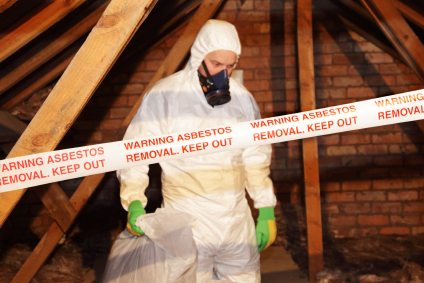Asbestos Testing: Vital Steps for a Safe Living Atmosphere
Asbestos Testing: Vital Steps for a Safe Living Atmosphere
Blog Article
The Full Process of Accredited Asbestos Checking to Ensure Property Conformity
In the realm of building management and compliance, the process of recognized asbestos screening stands as a critical component to ensure the safety and well-being of owners. From the first assessment to the last analysis of results, each phase plays a vital duty in establishing the visibility of asbestos within a property.
Accredited Asbestos Testing: First Analysis
In conducting the first assessment for recognized asbestos screening, a careful exam of the residential property's products is essential to precisely determine potential asbestos-containing materials. This essential step includes aesthetically examining all areas of the building, including ceilings, walls, floor covering, insulation, and various other structure products that might nurture asbestos. Special attention is provided to materials that are susceptible to harm or disruption, as these scenarios can launch hazardous asbestos fibers right into the air. Additionally, tasting of thought products might be needed to verify the presence of asbestos through research laboratory evaluation.
Certified asbestos assessors comply with strict protocols set by regulatory bodies to make certain the precision and integrity of the testing process. By diligently documenting searchings for and using advanced screening methods, assessors can offer residential property proprietors with a thorough record detailing the visibility of asbestos, if any, and the advised steps for reduction or elimination. This initial analysis sets the structure for subsequent actions to address asbestos issues and guarantee the safety and conformity of the home.
Sample Collection Treatments for Asbestos Examining
Efficient sample collection treatments are important in making certain precise asbestos screening results and conformity with regulatory standards. When accumulating samples for asbestos testing, it is vital to follow rigorous methods to reduce the danger of contamination and ensure the integrity of the outcomes.
Firstly, it is essential to identify the thought asbestos-containing products (ACMs) and focus on tasting areas based on factors such as the product's condition, access, and potential for disturbance. Asbestos Testing. Examples should be collected from numerous places within the residential or commercial property to offer an extensive evaluation of asbestos visibility
During example collection, licensed professionals should put on proper personal protective equipment (PPE) to secure against asbestos exposure. They must utilize tidy tools, such as non reusable handwear covers and plastic bed linen, to stop cross-contamination between samples. Samples should be carefully collected utilizing a specified technique, such as wet cleaning or coring, and securely secured in airtight containers to maintain their honesty during transport to the laboratory for analysis.
Laboratory Analysis Refine for Asbestos Examples
Upon conclusion of the sample collection procedure, the asbestos samples are thoroughly carried to certified research laboratories for careful analysis. The initial step in the laboratory evaluation procedure is sample preparation, where the accumulated samples are Learn More very carefully processed to draw out the asbestos fibers.

As soon as the analysis is full, an in-depth record is created, laying out the findings and validating whether asbestos exists, the sort of asbestos fibers identified, and the focus degrees. This information is crucial for homeowner to take the essential actions to make certain compliance with asbestos policies and protect the health and wellness of occupants.

Coverage and Interpretation of Asbestos Examination Outcomes
Accredited asbestos screening research laboratories offer in-depth records that offer critical insights into the existence, type, and concentration degrees of asbestos fibers found in samples accumulated from buildings. These records are crucial for building owners and supervisors to recognize the danger posed by asbestos and make educated decisions regarding its monitoring or elimination. The records home usually consist of details on the methods utilized for testing, the places where examples were taken, the kind of asbestos recognized (such as chrysotile, amosite, or crocidolite), and the concentration levels of asbestos fibers found.
Analyzing these results calls for knowledge to examine the prospective wellness threats connected with asbestos exposure, figure out the ideal strategy, and make certain governing conformity (Asbestos Testing). Depending upon the findings, recommendations may vary from proceeded tracking and upkeep to encapsulation or total asbestos reduction. Homeowner must very carefully examine these reports and talk to asbestos specialists to establish a comprehensive strategy for attending to any type of asbestos concerns determined
Making Sure Building Compliance With Asbestos Regulations
To maintain adherence with asbestos regulations, residential property owners should diligently carry out measures to make sure compliance with relevant laws and guidelines. Once asbestos is identified, residential property owners should adhere to asbestos monitoring plans that outline correct control, removal, or encapsulation treatments to avoid direct exposure and spread of asbestos fibers.
Residential or commercial property owners should give asbestos understanding training to workers and passengers to lessen the threat of asbestos exposure and guarantee proper handling of materials that may have asbestos. In addition, it is vital to stay notified about any updates or changes in asbestos laws to adjust monitoring methods as necessary. By proactively resolving asbestos compliance requirements, residential or commercial official site property proprietors can develop a safe environment for passengers and mitigate possible legal and wellness risks related to asbestos direct exposure.
Conclusion
To conclude, recognized asbestos screening is a vital procedure for guaranteeing property compliance with regulations. The preliminary evaluation, example collection procedures, research laboratory evaluation, and analysis of results are very important actions in this procedure. By following these treatments, homeowner can identify and resolve any kind of asbestos dangers existing, safeguarding the wellness and security of occupants and keeping conformity with regulatory requirements.
Report this page